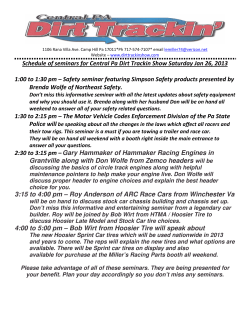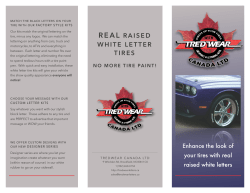
TREAD DEPTH AND TIRE SAFETY - Learning Center â State Farm
TREAD DEPTH AND TIRE SAFETY YOUR SAFETY ON THE ROAD RIDES ON REGULAR TIRE MAINTENANCE — LITERALLY. 70 At 70 mph, balding tires can increase average MPH stopping distance by 184 feet on wet roads. (That’s 4.5 school bus lengths.)1 184 FEET At half-tread, resistance to hydroplaning DROPS 8%.2 UNFORTUNATELY, HAVING WORN TIRES IS A COMMON PROBLEM: OF 11,500 VEHICLES STUDIED: 50% 10% Nearly 50 percent had at least ONE TIRE WITH 10 percent had AT LEAST ONE BALD TIRE.2 HALF-WORN TREAD. If your car’s tires are worn or balding, it’s time for new ones. Here are three simple ways to check tire treads regularly: MEASURE IT OUT. 1 ON NEW TIRES, the treads will measure 10/32 of an inch. 10/32" WORN TIRES: 4/32 of an inch BALD TIRES: 2/32 of an inch 4/32" 2/32" GRAB A COIN. 2 Place a penny or quarter upside down in the tread. Penny: IF TIRES ARE NEW: LINCOLN’S EYES WILL BE COVERED. WORN: THE TOP BALD: LINCOLN’S OF LINCOLN’S HEAD WILL BE COVERED. HEAD WILL BE FULLY VISIBLE. Quarter: NEW: PART OF WASHINGTON’S HEAD WILL BE COVERED. WORN: THE BALD: THE TREAD TREAD WILL JUST TOUCH THE TOP OF WASHINGTON’S HEAD. WILL ONLY REACH THE LETTERING. USE YOUR SENSES. 3 Worn or balding tires can have: EVEN APPEARANCE VISIBLE WEAR BARS WITH OUTSIDE TREAD RAISED SECTIONS SMOOTH SECTIONS ON TREAD GROOVES OTHER IMPORTANT TIRE MAINTENANCE These routine tasks will also help keep your tires in top shape: 1 CHECK PRESSURE. Use a tire pressure gauge to measure at least once a month. Reference your car’s owner’s manual for the recommended level. BALANCE AND ROTATE. On average, visit 2 3 a professional every 5,000 to 8,000 miles. ALIGN. As a rule of thumb, have a professional align tires every 6,000 miles or six months, whichever comes first. CLICK HERE for more tire safety tips from State Farm®. The information in this article was obtained from various sources. While we believe it to be reliable and accurate, we do not warrant the accuracy or reliability of the information. These suggestions are not a complete list of every loss control measure. The information is not intended to replace manuals or instructions provided by the manufacturer or the advice of a qualified professional. Nor is it intended to effect coverage under any policy. State Farm makes no guarantees of results from use of this information. We assume no liability in connection with the information nor the suggestions made. 1Tirebuyer.com; http://www.tirebuyer.com/education/how-to-measure-tread-depth#.VK_38YrF-TY 2Consumer Reports; http://www.consumerreports.org/cro/2012/12/how-safe-are-worn-tires/index.htm
© Copyright 2025













